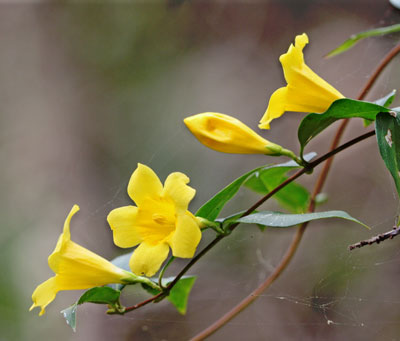Yellow Jessamine
Gelsemium sempervirens
Family: Gelsemiaceae
Natural History

Tubular flowers of yellow jessamine in early spring
Photo credit: Mary Keim (Flickr ID Mary Keim).
Used under a Creative Commons license. ![]()
Yellow jessamine is a climbing vine that is native to the southeastern United States. It is known by several names, including Carolina jessamine, poor man's rope, or yellow jasmin. It has also been known as "The Pride of Augusta," because it is found abundantly near Augusta, Georgia. Yellow jessamine is the state flower of South Carolina and it appears on that state's quarter along with the Carolina wren and the cabbage palmetto.
Yellow jessamine is particularly noticeable because it has showy, yellow flowers that appear in late winter or early spring when few other plants are in bloom. In some strains of the plant, the flowers are very fragrant and send a sweet, prevailing scent through the wintery woods.
From a distance, this plant can be easily confused with the invasive, non-native cat's-claw vine (Dolichandra unguis-cati), which climbs trees in similar habitats and also produces a similar display of bright yellow flowers. Both vines have opposite leaves, but the leaves of cat's-claw vine are compound, while the leaves of yellow jessamine are simple. In addition, cat's-claw vine blooms later in the springtime after yellow jessamine flowers have already disappeared. It is not likely that both vines would ever be in bloom in the same place at the same time.
Jessamine is easy to grow and is used as a landscape plant. It is often seen vining around mailboxes with its wiry stems and attractive blossoms. It can be cultivated in full sun to grow fuller, denser plants and is frequently used as a ground cover or a trellis decoration.
Yellow jessamine has been used by herbalists to treat eye ailments and as natural, perfumed hair oil. The essential oils of the plant are extracted for use in the perfume industry, since the pleasant odor is difficult to reproduce synthetically.
All parts of this plant are extremely poisonous, especially to livestock, if eaten; however, the bright yellow spring blossoms are a source of nectar for butterflies and deer often browse on the vegetation for food and fiber.
Jessamine is common in the coastal plains and Piedmont regions from Virginia to South Florida and west to Arkansas and Texas.
